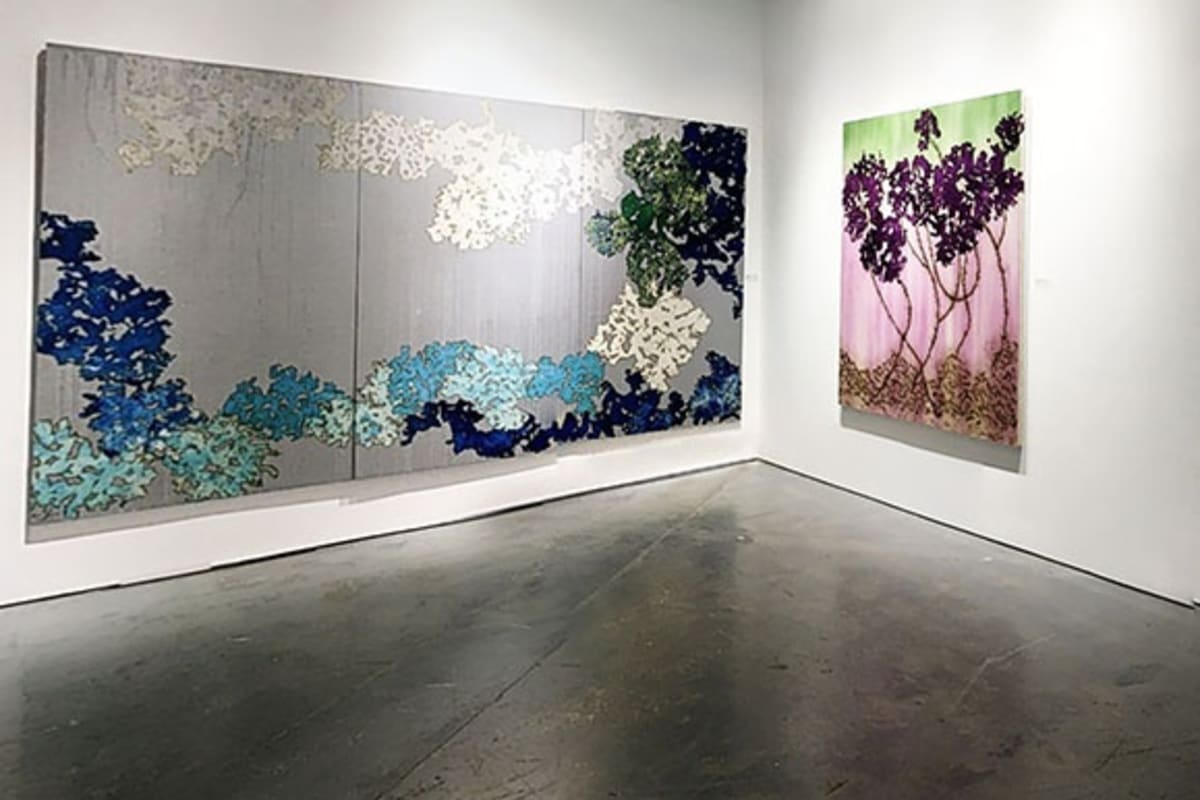
Jose Lima and William Spring from News Travels Fast sat down with Mira Lehr to discuss her new exhibition, Planetary Visions.
Q: Why did you decide to call this new exhibition Planetary Visions?
A: The title refers to the need for all of us to remain focused on a shared, united vision for the planet. Because of the pandemic and our compromised environment, the entire population of the world must be united in searching for the solutions to these problems that affect us all. This is a major turning point in history because for the first time we must now work together to address global problems without thoughts of borders and artificial separations between human beings.
If we can work together with this shared vision in mind, we can elevate and expand our power as a species. We can transcend a limited future, and create a unified and powerful new story for planet Earth that benefits all of humanity.
Planetary Visions also refers to my vision of the mythical places featured on my paintings. Invented places bring to light areas of global disturbances where effects of the pandemic, climate change, pollution, melting ice caps, flooding, storms, fires, extinctions, mutations, and more take place. A poetic realism is achieved by creating imaginary places as a ground to contain the realistic happenings. It is cause for concern and I am concerned.
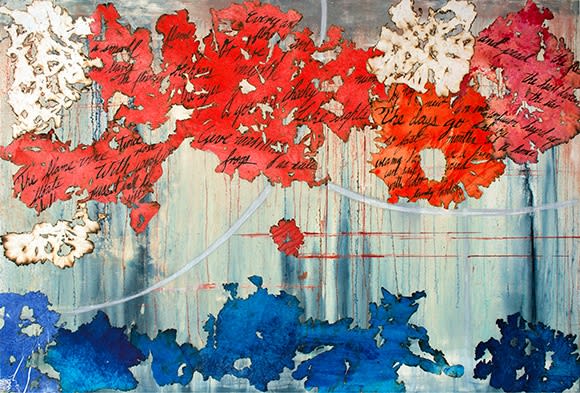
Multiplicity; 2019; Burned and dyed Japanese paper, handwriting, ink and acrylic on canvas; 48 x 72 inches (121.9 x 182.9 cm)
Q: Did these new ideas, this departure, come to you during the pandemic and quarantine?
A: Yes. This time of reflection, this time of concern about the earth has changed everything. Everything is different, and I don’t think the planet will ever be the same again. We’re on the brink of making it ─ or not making it.
I’m more involved now in a different kind of consciousness, and that’s where this is all coming from. I don’t stress out so much that something is in the wrong place or the right place in my work. Somehow because I’m not so focused on that, everything is coming out pretty well integrated without my having to overthink it.
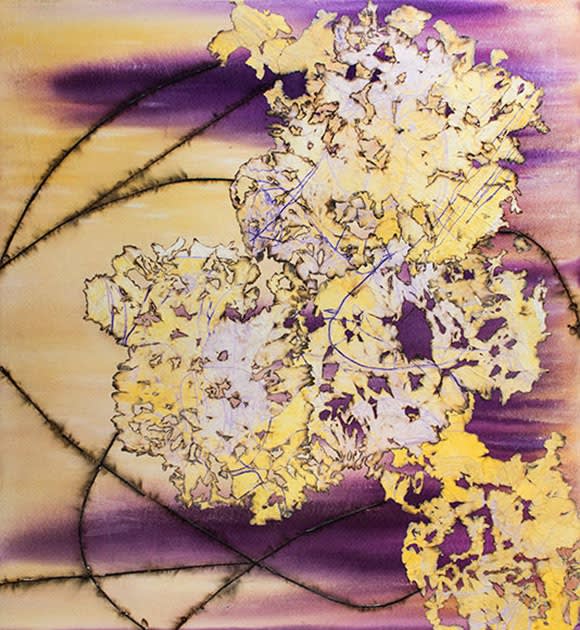
Embrace I; 2019; Burned and dyed Japanese paper, ignited fuses, ink and acrylic on raw canvas; 50 x 54 inches (127 x 137.2 cm)
Q: How has it been for you, creating work during the quarantine?
A: Different. I have more interludes where I can breathe, and go to another place in my soul. It is a more spiritual time. This has turned out to be the most productive time of my six decades of artmaking. I have never created so much new work during one time.
Q: How do these paintings represent a departure for you?
A: Much of my previous work focused on structure and organization of the picture plane very much in the modernist tradition, where the subject matter is more abstract, integrated and contains less narrative.
Now, since I have worked out many of those problems, I feel the need to explore new creative pathways now. To create new imagery of events in nature, creating poetic visions of the earth and as a result, a more inventive and carefree approach has taken over.
The pure abstractions and the focus on organization of the past are now replaced by more of a subject matter and a narrative about the planet and these visions. I feel this is all new. I don’t know where it’s coming from. I have no way to analyze it. It’s just different.
I no longer have art history sitting on my shoulders, and watching what I am doing. I am more of an explorer now.
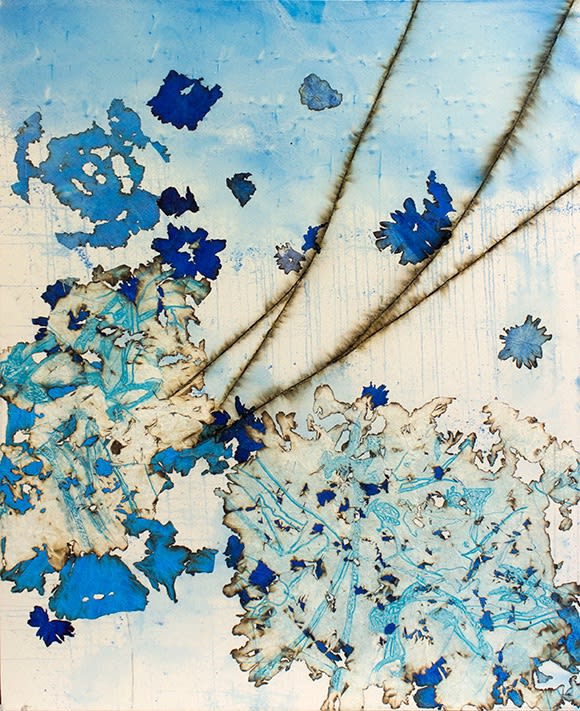
Perfect Flight; 2019; Burned and dyed Japanese paper, ink and acrylic on canvas; 60 x 48 inches (152.4 x 121.9 cm)
Q: How has this new approach changed the way your paintings look?
A: You can’t really pinpoint them in the same way as my previous work, which was part of a certain tradition. These are original visions, and it feels to me that nobody else has done anything like this. I feel it’s coming from a different place, more spiritual perhaps.
Q: Because of the pandemic, people all across the globe, no matter where they live, are concerned about how this global problem will affect them. Everybody is worried about the same issue.
A: That is a planetary vision because everybody on the planet is worried about it. This pandemic is that kind of a planetary threat. It affects everybody everywhere. Nobody is safe from it. That makes us look at the world differently. I think we can now see a worldwide impact rather than local.
Q: Many people comment that your work has a spiritual resonance. Could you expand on this spiritual element for us?
A: If I’m trying to contrast with the physical, the spiritual is more of a thing of the soul. It’s not as concrete, as tactile, or as real. The experience is more of a dream or meeting in another plane of consciousness. I don’t analyze as much as I used to. We are all like armchair travelers now, using our minds and imaginations instead of airplanes to take us to exotic locales, because most of us are not traveling during the pandemic. Art can take us to these places.
Q: What kind of places?
A: Places of the spirit. Poetry. Things of a different consciousness. Also maybe some intuitions of what is happening on the Planet. Places where thoughts come in from other worlds.
Q: Do you experience actual visions of the planet? Do you literally see planetary visions?
A: Visions of wellbeing, and visions of threats too. Not centered on physical visions but more on positive feelings versus frightened, apprehensive feelings. The Light and the Dark.
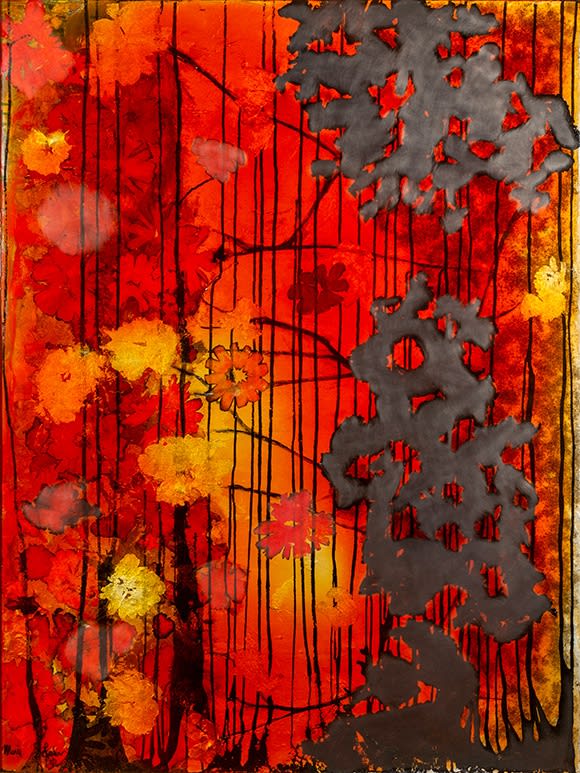
A Mystic Silence that can not Engage; 2020; Burned and dyed Japanese paper, ink, hand drawing, acrylic, ignited gunpowder and resin on canvas; 40 x 30 inches (101.6 x 76.2 cm)
Q: This new exhibition features contrasting paintings (done at the same time, during 2020), where some are more light and airy, yet and others are darker, more ominous. Why do you think these two contrasting visions came to you at the same time, during quarantine?
A: There are moments of pure joy and moments of despair.
When I feel we are aware of the dangers that face our planet and are trying to help it, or when a new invention is created that shows the wonder of our beautiful minds or I see or hear or read something profound that man has created, I feel good.
There are the times when mankind is limiting itself, horribly cruel, damaging the planet due to greed and selfishness, and I go into a darker mood.
And, of course, life itself can be at times tragic. Then, by the time we learn what life is about and refine our knowledge and skills, it is time for each of us to leave this plane of existence!

The Phantom of Golden Sunlight; 2020; Burned and dyed Japanese paper, ink, acrylic, hand drawing and resin on canvas; 40 x 30 inches (101.6 x 76.2 cm)
Q: We have light and dark paintings, and then a series of map-like paintings of imaginary places. Where do these map-like paintings of imaginary places fit in with the other works in this show?
A: The resins and the collages of the burnt paper are more tactile. You are affected by a “wow” type of physical sensation from them. They are multi-dimensional, and the colors are glowing, so you’re affected very physically by them.
The map-like paintings of imaginary places are less immediately sensuous. They are more ethereal, and you can ponder them. Sometimes I think a feeling may come to you. It may not be a sock in the gut like the others, not immediately responsive, but it’s responsive in another way where after you sit and contemplate it a little longer and you can feel where you are.

Red Orange Yellow; 2019; Burned and dyed Japanese paper, ignited gunpowder, fuses and acrylic on canvas; 60 x 54 inches (152.4 x 137.2 cm)
Q: The imaginary places on the globe seem to have a fuse running through them. You have emphasized before how time is running out on the planet, to save the Earth from climate extinction. Could this fuse represent a ticking time bomb, a warning?
A: You can interpret it like that. When I use the fuse I use it as a contrast between what is and what isn’t. A contrast between construction and destruction. If you let it go too far, you burn up the whole thing. If you stop it in the right time, you have a timeline of something happening, leaving its mark and then being gone.
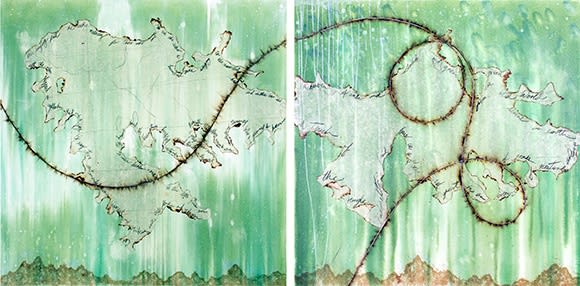
What this Earth does not Remember I and II (diptych); 2020; Burned and dyed Japanese paper, ink, acrylic, hand drawing, ignited gunpowder and fuses on canvas; 48 x 96 inches (121.9 x 243.8 cm)
Q: There are also new types of planetary visions here, aside from the environmental issues. We rarely see anything in the news about other parts of the world, how is this reflected in your new work?
A: There needs to be a total vision of a globe. Not of a particular state or country. That’s the reason I didn’t do local subject matter like scenes from a particular state. These are shapes of landmasses which don’t really exist. The problem with boundaries, is that they make people think ─ “Well, this country way over there is over-polluted, but I’m in America.” As Buckminster Fuller said, “We are a one world landmass island, surrounded by water.” Whatever goes on in Europe or in Asia will come to us too, and vice-versa.
Q: Your new works also bring the cosmos to mind. It’s as if you are receiving messages from the universe, not just one planet . . .
A: Absolutely. I do a lot of reading. I’m an armchair scientist and I love to read about the cosmos and the universe. It tells us what a tiny part we are in it. The universe is so vast and so amazingly intricate and energetic with all of these huge events taking place. Full of explosions, blackholes, and supernovas. We are just a teeny part of it, hardly even there, we’re so small. It gives me a sense of an overwhelming, giant, functioning cosmos– whatever it is out there – that impacts us. It is a mystery we’ll never understand, but it’s there and we feel it. We don’t have the brain power to understand it.
How very small we are in this vast enterprise is quite amazing. It gives me a feeling of just some miracle that’s happened that we are inhabiting a planet, spinning around the universe at these great speeds, and other planetary and galactic bodies around us spinning around at great speeds.
Art gets us more out there, to really understand what’s going on. There are so many dimensions, we don’t have the brain capacity to ultimately understand what it is. However, we do have the capacity to wonder about it. It is a great unknown mystery. Art and creativity take us out of our mundane, sometimes petty kind of lives we lead when we are not on the path to understand beyond ourselves.
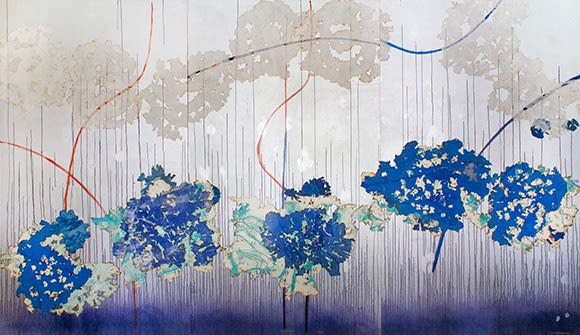
Dance; 2019; Burned and dyed Japanese paper, acrylic and ink on wood panel; 96 x 144 inches (243.8 x 365.8 cm)
Q: Maybe, coming from out of the cosmos and landing in this visionary moment. We are all in this visionary moment together. Is it as though you are receiving messages from beyond, to create these new works during the pandemic?
Yes ─ I am. That’s where all creativity comes from. It’s not like “I’m going to do this, I’m going to do that.” It comes naturally, from some other place. Whatever the viewer wants to see in my art is fine with me. But I would say, if they would linger a little bit longer, and not think only about something as practical as where this would hang . . . if they would just linger a little and contemplate. There may be something that will come through that will make them feel a little bit of wonder.
The new exhibition, “Planetary Visions 2020: Mira Lehr from Spaceship Earth,” is on view until January 16 at our Boca Raton, Florida, gallery. You can also experience the exhibition via a virtual tour.

